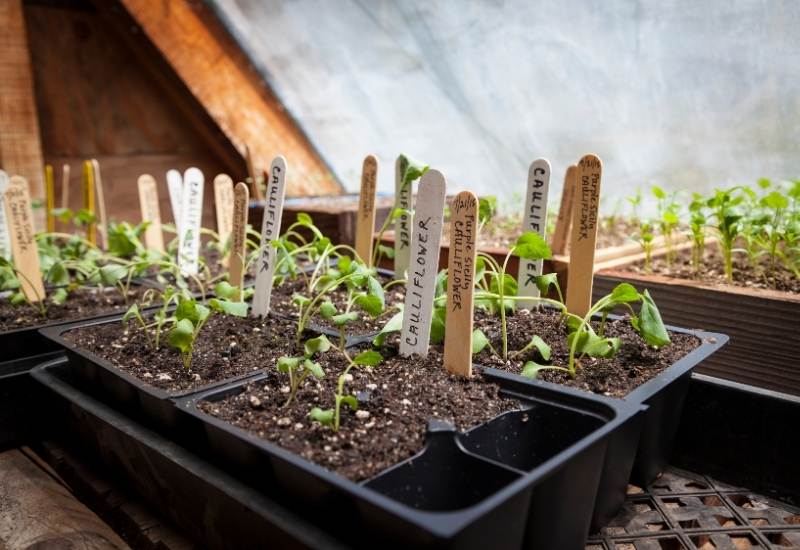
All of the seeds are in hand, and the materials you need to start seeds are at your home. Now, you have to figure out when to start seeds indoors.
Starting seeds indoors at the right time is the first big step you have to take as a gardener. Incorrect timing could delay planting your seedlings outside or cause the seedlings to stay inside longer than needed, risking their overall health.
The average recommendation is to start your seeds six weeks before your final frost date in your area. Some seeds may be started eight weeks before this date or as soon as four weeks before hand. Look at each plant’s requirements before starting your seeds.
Let’s take a look at when to start seeds indoors at the right time to give your plants the best start.
Start a Seed Starting Journal
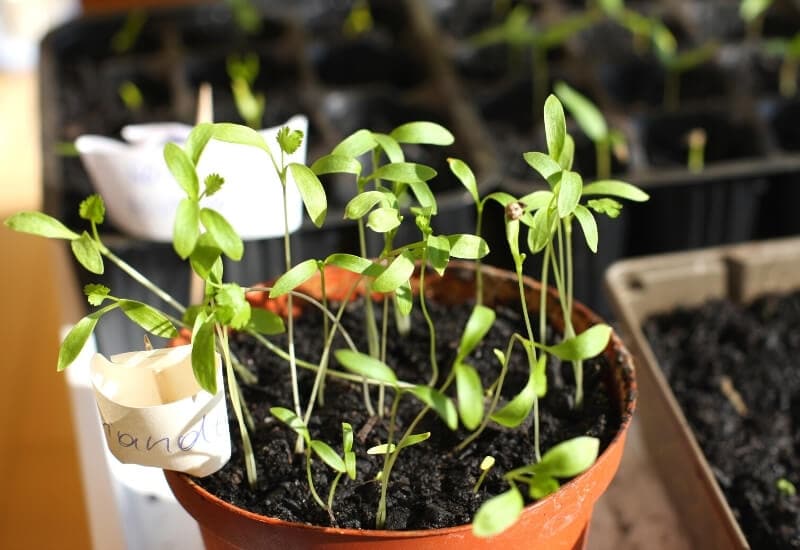
I recommend that all gardeners have a seed starting journal where you write down the dates each year you start your seeds. It makes the following years easier.
By having a seed starting journal, you’ll know when you start your tomato seeds the previous winter and when you sowed your first row of carrot seeds. It’s also a place that you can write down observations to help in the upcoming years.
Perhaps one year, you started seeds too late; write that down so, in the following year, you don’t make the same mistake.
As you add more seed varieties and types, having a journal becomes an indispensable item. It makes creating a seed starting calendar much easier.
Not All Seeds Need to Be Started Indoors
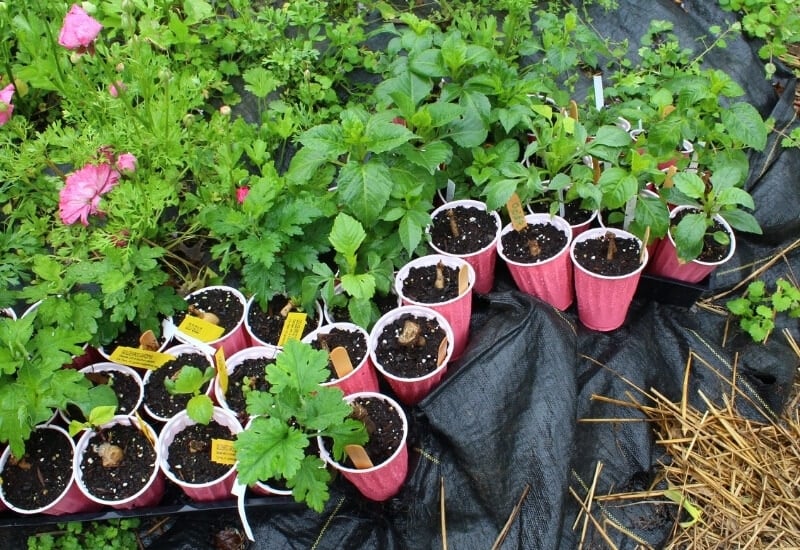
The first thing that you need to know is that you must start not all seeds indoors. Some plants are worse off if you start them in containers early because they are prone to becoming root-bound, making transplanting into your garden troublesome.
Here are the seeds that you can set aside and plan to sow directly outside.
I suggest that you store these separately so that you aren’t accidentally confused. Keeping them together makes it easier to find them later when it’s time to start sowing seeds outside.
Several annual flowers may be directly sown as well, such as:
If your growing season is shorter, then consider starting a few of these plants inside if you have space. Perennial flowers usually must be started indoors.
Which Seeds to Start Indoors?
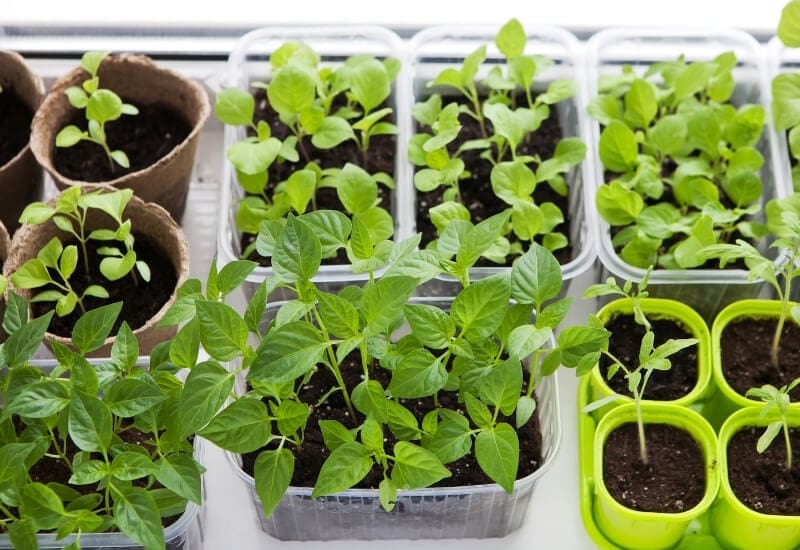
Now that you sorted out your seeds that you can directly sow outside, here are the plants that you need to start inside and grown for transplant.
This isn’t an exhaustive list; it’s impossible to name all of the flowers and herbs you might want to start inside.
However, each seed packet will contain the information needed to determine when to start the seeds indoors.
When to Start Seeds Indoors?

Each plant has a different recommendation for when to start the seeds indoors. The general rule is that most annual vegetables should be started indoors six weeks before the final frost date in your area. Most seed packets list this information as well, stating something like, “start the seeds indoors six weeks before the final frost date.”
Figure out when to start your seeds indoors:
All recommendations for starting seeds are based on your final frost date, which varies from place to place. Knowing your first and last frost dates is valuable for all gardeners. Use a tool to find your USDA gardening zone and frost dates.
Once you figure out your last frost date for your area, mark this date on your calendar. Remember, this is no guarantee; rogue frosts happen after this date frequently, so it won’t replace keeping a close eye on your forecast before planting.
Use this data to decide when to start seeds indoors. For example, gardeners should start basil seeds six weeks before your final frost date. Find that day on your calendar and count backward six weeks. Mark that on your calendar as the day you need to start basil seeds.
Indoor Seed-Starting Chart
Use this seed starting chart of know when to start vegetables and herbs seeds indoors and then to transplant outside, based on the frost date date in your area.
Crop | Weeks before final frost date to start the seeds |
Artichokes | 8 weeks |
Basil | 6 weeks |
Broccoli | 4-6 weeks |
Brussels Sprouts | 4-6 weeks |
Cabbage | 4-6 weeks |
Calendula | 6-8 weeks |
Cauliflower | 4-6 weeks |
Celery | 10-12 weeks |
Collards | 4-6 weeks |
Echinacea | 6-8 weeks |
Eggplant | 8-10 weeks |
Kale | 4-6 weeks |
Leeks | 8-10 weeks |
Marigolds | 6-8 weeks |
Morning Glory | 3-4 weeks |
Mustard | 4-6 weeks |
Okra | 4-6 weeks |
Onions | 8-10 weeks |
Oregano | 4-6 weeks |
Parsley | 9-10 weeks |
Peppers | 8 weeks |
Sage | 6-8 weeks |
Spinach | 4-6 weeks |
Swiss Chard | 4-6 weeks |
Tomatoes | 6-8 weeks |
Yarrow | 8-12 weeks |
Can I Start Seeds Earlier?
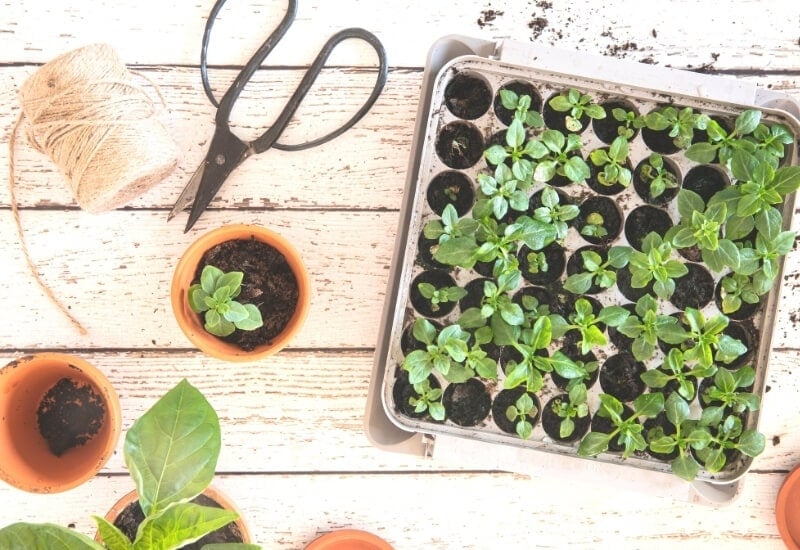
Yes, but starting seeds earlier will require some adjustments to make it work. If you start seeds in your basement or somewhere cold, make sure the temperature isn’t too cold for the seeds to germinate. One to two weeks makes a considerable difference in temperatures in the spring.
It’s possible to put your started seedlings outside early with the right season extenders. Cold frames, greenhouses, row covers, and mini hoop houses give you the opportunity to place started tender seedlings outside several weeks earlier than planned.
I found that I can place started seedlings under mini hoops up to two weeks sooner than I planned to put them outside. Two weeks makes a big difference in growth, leading to a quicker harvest.
Can I Start Seeds Later?

Yes, it’s possible to start seeds later than the recommended timeframe. If your seed starting location is warmer than 70℉, seeds germinate and grow faster, so you can remove a week off the schedule. Heat leads to faster growth; you might have large seedlings to transplant!
Even if the location isn’t as warm, starting seeds a bit later than planned isn’t the end of the world. It means that your harvest will be delayed slightly, but as long as you don’t enter your first frost date with unharvested summer crops, it’ll be fine.
Final Thoughts
Each plant has a different requirement for when to start seeds indoors. The general recommendation is to begin all annuals and perennials six to eight weeks before the final frost date in your region.
Some plants need to be started later or earlier; check the seed packet for further information to make sure your timing is appropriate.

Written By
Bethany Hayes
Bethany is a suburban homesteader, growing over half of the vegetables, fruit, and herbs that her family of six needs each year. She raises chickens and homeschools her children. When she isn’t spending time tending to her garden, you can find her reading, crocheting, and canning.

Very helpful but it would be nice to see a few more plants starting weeks in the box with the blue heading. Or maybe a link to a site that says like maybe 100s of plants and when to start them.
I think there is a typo in the “planting time is important” paragraph. It says that peas should be started indoors 6-8 weeks before last frost and peppers and tomatoes start inside 2-3 weeks. But then in the graph it is assumed that peas are started outside. I believe the cool weather crops should be sowed outside 2-3 weeks before the last frost and warm weather vegetables should be started inside 6-8 weeks before last frost. Is that what you meant? Otherwise I am very confused lol.